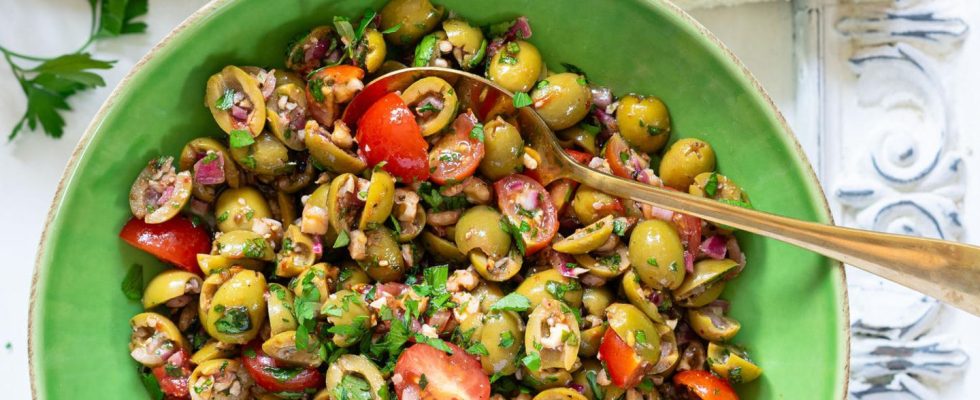Jingalov Hats
Bread flatbreads filled with herbs
4 servings
Ingredients:
For the dough:
150 ml lukewarm water 1 teaspoon coarse salt
200 g wheat flour (Type 550) + some flour for the work surface
some vegetable oil
For the filling:
450 g of different herbs and green leafy vegetables to taste (a balanced mixture of not too hard varieties such as coriander, dill, parsley, tarragon, spinach, chard, rocket, kohlrabi leaves, carrot greens, chervil, basil, borage, wild garlic, dandelion is ideal , radish greens, watercress, collards, purslane and other wholesome herbs)
2 spring onions
2 tsp sweet paprika powder 1 tsp salt
1⁄2 teaspoon cayenne pepper
2 tsp lemon juice
1 tbsp vegetable oil
Preparation:
1. For the dough, mix 150 ml lukewarm water with salt in a large mixing bowl. Stir in the flour in portions and knead briefly to form a sticky dough. Dust the work surface with flour and knead the dough with your hands for a few minutes until it feels smooth and no longer sticky.
2. Clean the mixing bowl and coat the inside thinly with a little oil. Form the dough into a large ball, place it in the bowl and let it rest, covered with a kitchen towel, for at least 20 minutes and up to 1 hour.
3. Meanwhile, wash all the herbs and leafy vegetables for the filling, shake dry and chop finely. Clean and wash the spring onions and cut them into very fine rings. In a bowl, mix the herbs and spring onions with paprika powder, salt, cayenne pepper, lemon juice and oil and knead lightly with your hands.
4. Then dust the work surface again with flour. Place the dough on top and divide into four equal parts and shape each part into a ball.
5. On the floured work surface, roll out the first ball into a thin circle using a rolling pin; the dough should ultimately be about the size of a dessert plate. Place about 100g of the herb filling in the middle of the dough – don’t worry, it may look like too much, but it’s just right.
6. Carefully lift the dough on the right and left edges and press it together with your fingers in the middle over the filling. Proceed in the same way up and down from this center and press the remaining open edge together to create a continuous seam. Press the two tips together well and fold them in slightly so that nothing can fall out. Now it should look like a giant dumpling. Press the seam of the dough with the edge of your hand so that the flatbread is well sealed and the seam does not open during cooking. Now place the flatbread on the work surface with the seam side down and flatten it slightly with the palm of your hand until it is only about 1 cm thick.
7. Do the same with the second dough ball, leave the third and fourth balls to rest.
8. Heat a sufficiently large pan on the stove (cast iron or wrought iron pans are ideal, but pans with high thermal conductivity also work well for this). Place a flatbread with the seam side down and cook over medium heat for about 3 minutes, then turn and cook for another 2 minutes. Both sides should be golden brown and no longer look raw. If necessary, cook each side for 1-2 minutes each. Remove and place on a serving platter. Cook the second filled flatbread in the same way.
9. While the first two flat cakes are cooking in the pan, fill the two remaining flat cakes with the herb mixture, close them, press them flat and cook them one after the other in the pan.
10. Serve Jingalov Hats immediately warm, but they taste just as good cold. The filled flatbreads will last for about 3 days in the refrigerator and up to 2 months in the freezer. Bake the frozen flatbreads in the oven at 200 °C for about 10 minutes until crispy.
“Jingalov Hats” literally means “bread with herbs”, where “Jingal” is a dialect word and comes from the Persian “jangal”, which means “deciduous forest”. These flat breads filled with fresh herbs are a specialty of the Artsakh (Nagorno-Karabakh) and Syunik regions, which are particularly fertile and mountainous at the same time. According to the traditional recipe, at least ten different types of herbs and leafy vegetables are used. Armenian families usually prepare the flatbreads directly on the steel plate of their wood-burning oven or a grill plate.
You can enjoy Jingalov Hats as breakfast, lunch, dinner or as a snack in between.

